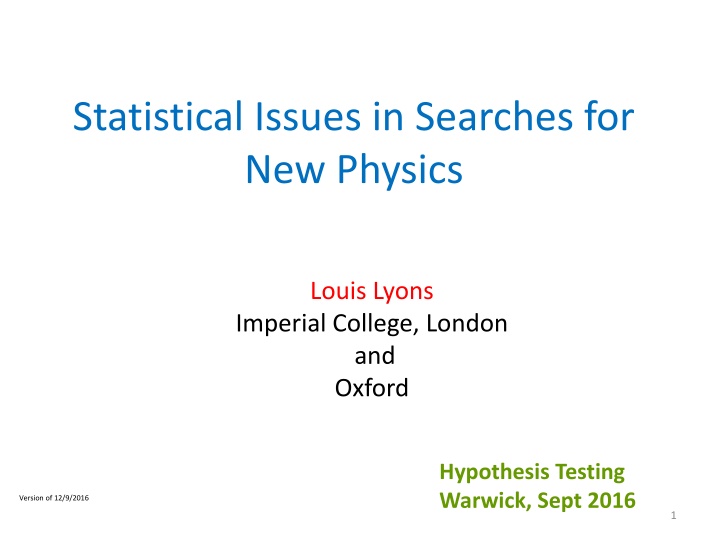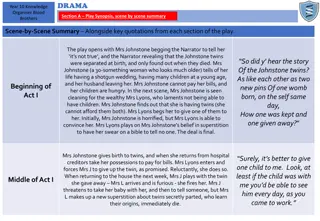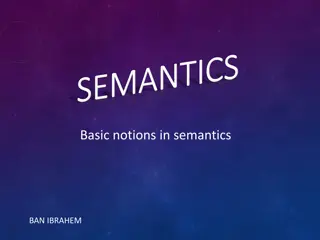
Searches for New Physics: Statistical Analysis and Hypothesis Testing
Explore statistical issues in the search for new physics, emphasizing the importance of robust statistical analysis in high-energy physics experiments. Topics include hypothesis testing, L-ratio, Bayesian methods, p-values, and examples of particle physics hypotheses.
Download Presentation

Please find below an Image/Link to download the presentation.
The content on the website is provided AS IS for your information and personal use only. It may not be sold, licensed, or shared on other websites without obtaining consent from the author. If you encounter any issues during the download, it is possible that the publisher has removed the file from their server.
You are allowed to download the files provided on this website for personal or commercial use, subject to the condition that they are used lawfully. All files are the property of their respective owners.
The content on the website is provided AS IS for your information and personal use only. It may not be sold, licensed, or shared on other websites without obtaining consent from the author.
E N D
Presentation Transcript
Statistical Issues in Searches for New Physics Louis Lyons Imperial College, London and Oxford Hypothesis Testing Warwick, Sept 2016 Version of 12/9/2016 1
Theme: Using data to make judgements about H1 (New Physics) versus H0 (S.M. with nothing new) Why? HEP is expensive and time-consuming so Worth investing effort in statistical analysis better information from data Topics: LEE = Look Elsewhere Effect Why 5 for discovery? Why Limits? CLs for excluding H1 Background Systematics Coverage p0 v p1 plots Example: Higgs Discovery, Mass and Spin Examples of Particle Physics hypotheses Why we don t use Bayes for HT Are p-values useful? Why p L-ratio Conclusions 2
Examples of Hypotheses 1) Event selector (Event = particle interaction) Events produced at CERN LHC at enormous rate Online trigger to select events for recording (~1 kiloHertz) e.g. events with many particles Offline selection based on required features e.g. H0: At least 2 electrons H1: 0 or 1 electron Possible outcomes: Events assigned as H0 or H1 2) Result of experiment e.g. H0 = nothing new H1 = new particle produced as well (Higgs, SUSY, 4thneutrino, ..) Possible outcomes H0 H1 X Exclude H1 X Discovery X X ? . No decision 3
Bayesian methods? Particle Physicists like Frequentism. Avoid personal beliefs Let the data speak for themselves For parameter determination, a) Range of prior for unimportant, provided b) Bayes upper limit for Poisson rate (constant prior) agrees with Frequentist UL c) Easier to incorporate systematics / nuisance parameters BUT for Hypothesis Testing (e.g. smooth background versus bgd + peak), does not cancel, so posterior odds etc. depend on . Compare: Frequentist local p global p via Look Elsewhere Effect Effects similar but not same (not surprising): LEE also can allow for selection options, different plots, etc. Bayesian prior also includes signal strength prior (unless -function at expected value) Usually we don t perform prior sensitivity analysis.
(a) (b) pdf s and p-values H0 H1 tobs t t tobs p1 p0 (c) With 2 hypotheses, each with own pdf, p-values are defined as tail areas, pointing in towards each other H0 H1 tobs t 5
Are p-values useful? Particle Physicists use p-values for exclusion and for discovery Have come in for strong criticism: People think it is prob(theory|data) p-values over-emphasize evidence (much smaller than L-ratio) Over 50% of results with p0 < 5% are wrong In Particle Physics, we use L-ratio as data statistic for p-values Can regard this as: p-value method, which just happens to use L-ratio as test statistic or This is a L-ratio method with p-values used as calibration
Are p-values useful? Particle Physicists use p-values for exclusion and for discovery Have come in for strong criticism: People think it is prob(theory|data) Stop using relativity, because misunderstood? p-values over-emphasize evidence (much smaller than L-ratio) Is mass or height `better` for sizes of mice and elephants? Over 50% of results with p0 < 5% are wrong Confusing p(A;B) with p(B;A) In Particle Physics, we use L-ratio as data statistic for p-values Can regard this as: p-value method, which just happens to use L-ratio as test statistic or This is a L-ratio method with p-values used as calibration
Why p Likelihood ratio Measure different things: p0 refers just to H0; L01 compares H0 and H1 Depends on amount of data: e.g. Poisson counting expt little data: For H0, 0 = 1.0. For H1, 1 =10.0 Observe n = 10 p0 ~ 10-7L01 ~10-5 Now with 100 times as much data, 0 = 100.0 1 =1000.0 Observe n = 160 p0 ~ 10-7L01 ~10+14 8
Look Elsewhere Effect (LEE) Prob of bgd fluctuation at that place = local p-value Prob of bgd fluctuation anywhere = global p-value Global p > Local p Where is `anywhere ? a) Any location in this histogram in sensible range b) Any location in this histogram c) Also in histogram produced with different cuts, binning, etc. d) Also in other plausible histograms for this analysis e) Also in other searches in this PHYSICS group (e.g. SUSY at CMS) f) In any search in this experiment (e.g. CMS) g) In all CERN expts (e.g. LHC expts + NA62 + OPERA + ASACUSA + .) h) In all HEP expts etc. d) relevant for graduate student doing analysis f) relevant for experiment s Spokesperson INFORMAL CONSENSUS: Quote local p, and global p according to a) above. Explain which global p 9
Why 5 for Discovery? Statisticians ridicule our belief in extreme tails (esp. for systematics) Our reasons: 1) Past history (Many 3 and 4 effects have gone away) 2) LEE 3) Worries about underestimated systematics 4) Subconscious Bayes calculation p(H1|x) = p(x|H1) * (H1) p(H0|x) p(x|H0) (H0) Posterior Likelihood Priors prob ratio Extraordinary claims require extraordinary evidence N.B. Points 2), 3) and 4) are experiment-dependent Alternative suggestion: L.L. Discovering the significance of 5 http://arxiv.org/abs/1310.1284 10
How many s for discovery? SEARCH SURPRISE IMPACT LEE SYSTEMATICS No. Higgs search Medium Very high M Medium 5 Single top No Low No No 3 SUSY Yes Very high Very large m Yes 7 Bs oscillations Medium/Low Medium No 4 sin22 , m2 Neutrino osc Medium High No 4 Bs No Low/Medium No Medium 3 Pentaquark Yes High/V. high M, decay mode Medium 7 (g-2) anom H spin 0 4th gen q, l, Yes High No Yes 4 Yes High No Medium 5 Yes High M, mode No 6 Dark energy Yes Very high Strength Yes 5 Grav Waves No High Enormous Yes 8 Suggestions to provoke discussion, rather than `delivered on Mt. Sinai 11 Bob Cousins: 2 independent expts each with 3.5 better than one expt with 5
WHY LIMITS? Michelson-Morley experiment death of aether HEP experiments: If UL on expected rate for new particle expected, exclude particle Production rate CERN CLW (Jan 2000) FNAL CLW (March 2000) Heinrich, PHYSTAT-LHC, Review of Banff Challenge Prediction Exptl UL MX 13
CMS data, excludes X gg with MX<2800 GeV
CLs for exclusion CLs = p1/(1-p0) diagonal line Provides protection against excluding H1 when little or no sensitivity `Conservative Frequentist approach H0 H1 t N.B. p0 = tail towards H1 p1 = tail towards H0 16
-2lnL s 18
Coverage best * What it is: For given statistical method applied to many sets of data to extract confidence intervals for param , coverage C is fraction of ranges that contain true value of param. Can vary with * Does not apply to your data: It is a property of the statistical method used It is NOT a probability statement about whether true lies in your confidence range for C( ) Ideal coverage plot 68% * Coverage plot for Poisson counting expt Observe n counts Estimate best from maximum of likelihood L( ) = e- n/n! and range of from ln{L( best)/L( )} 0.5 For each true calculate coverage C( true), and compare with nominal 68% 19
Coverage : lnL intervals for P(n, ) = e- n/n! (Joel Heinrich CDF note 6438) -2 ln < 1 = p(n, )/p(n, best) Coverage Discontinuities because data n are discrete UNDERCOVERS because lnL intervals not equiv to Neyman constructiom true 20
p0 v p1 plots Preprint by Luc Demortier and LL, Testing Hypotheses in Particle Physics: Plots of p0 versus p1 For hypotheses H0 and H1, p0 and p1 are the tail probabilities for data statistic t Provide insights on: CLs for exclusion Punzi definition of sensitivity Relation of p-values and Likelihoods Probability of misleading evidence Jeffries-Lindley paradox 21
Search for Higgs: H : low S/B, high statistics 22
Mass of Higgs: Likelihood versus mass 25
Comparing 0+ versus 0- for Higgs (like Neutrino Mass Hierarchy) http://cms.web.cern.ch/news/highlights-cms-results-presented-hcp 26
Conclusions Many interesting open statistical issues Some problems similar to those in other fields e.g. Astrophysics Help from Statisticians welcome. We would rather use your circular wheels than our own square ones. Come and help us










